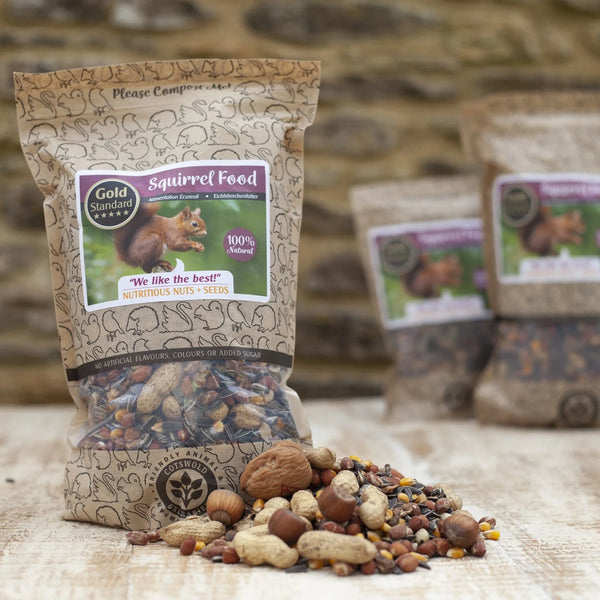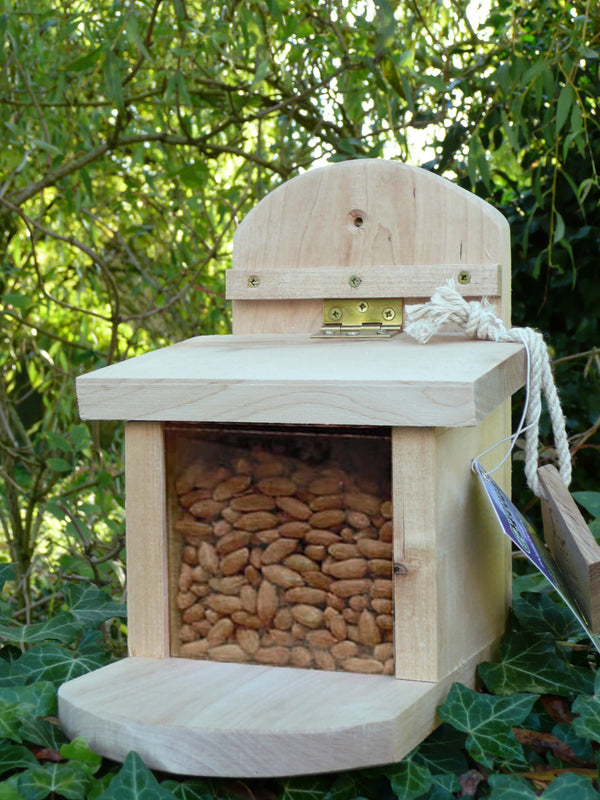About Red Squirrels - Red Squirrel Facts & Information

Known for their striking colour, the Eurasian Red Squirrel is a much loved woodland animal in the UK, and they are the only native Squirrel. (They've been here for around 10,000 years!)
These tree Squirrels have orange reddish fur that ranges from more brown to a ginger colour and changes during the cold winter months. In the Autumn, you might be lucky enough to catch a glimpse of these creatures collecting food to store before the harsh weather.
In the winter, these British mammals develop ear tufts, and although they don't hibernate, they are much less active. Red Squirrels have a fluffy tail that's almost as long as their body.
They use this for balancing, keeping warm and to communicate with other Squirrels.
Why Are Red Squirrel Populations Endangered?
In the UK, there are only around 120,000 Red Squirrels, and 75% of this population calls Scotland home.
Grey Squirrels (Sciurus carolinensis), one of the Red Squirrels biggest challenges, were introduced to the UK in the late 19th century. They are not a native species, they actually come from North America. Since their introduction, they have become widespread in the UK.
The main problem is competition for resources; Larger Greys are more aggressive and adaptable compared to the Reds and they out compete them for food and habitat.
Grey Squirrels have another upper hand when it comes to being able to digest acorns - it allows them to have a significant advantage in mixed woodland and Grey Squirrels live in a wider range of woodlands.
Grey Squirrels carry the Squirrelpox virus, it's harmless to them, but it kills Red Squirrels (Sciurus vulgaris) and this has taken a significant toll on the populations.
Another major factor in the decline of this species is habitat loss. Suitable habitats have been lost to urbanisation, agricultural practices and other project work, this means there a lot less space for these mammals to nest and live.
The Conservation Efforts
Across the UK, there are many Red Squirrel Conservation efforts taking place. The control of Grey Squirrels is incredibly important if we want to the native Red Squirrels to survive.
To protect Red Squirrels there are control programmes that help reduce the competition and disease transmission. This is done through the culling of Grey Squirrel populations in areas where the two species of red and grey Squirrels live. This method is mainly used in Scotland and Northern England.
Planting coniferous trees, and restoring the Red Squirrel natural habitat is also a method of conservation, alongside this Red Squirrel Nest Boxes are used too. Red Squirrels rely on these habitats so it's incredibly important to do this.
There are also conservation groups for these small mammals, such as Saving Scotland's Red Squirrels and Wight Squirrel Project, these significant groups aim to protect Red Squirrels and enhancing populations across Scotland and other British Isles. Through these projects, Red Squirrel numbers have been seen to rise in areas where they take Grey Squirrels away.
Red Squirrel Habitat

Red Squirrels prefer coniferous woodlands, such as pine forests, which provide an ample supply of seeds and shelter. These forests are ideal because the dense tree canopy offers protection and a suitable environment for building nests.
While Red Squirrels can also inhabit broadleaved woodlands, these areas are less preferred compared to coniferous forests. The availability of food and suitable nesting sites can be less predictable in broadleaved woodland.
Conservation efforts often include creating buffer zones to limit the spread of grey squirrels into areas where red squirrels are being protected. This helps reduce competition and disease transmission.
What Do Red Squirrels Eat?

A significant part of the Red Squirrel's diet comes from seeds of coniferous trees, such as pine, spruce, and fir. Pine nuts, in particular, are a crucial food source, and Red Squirrels are adept at extracting these seeds from pine cones.
Red Squirrels also eat acorns from oak trees. They store acorns in caches to use as a food source during the winter months. Hazelnuts are also an important food source.
Red Squirrels consume various berries, including blackberries, raspberries, and strawberries. These fruits are particularly important in the summer and early autumn when they are in season.
Red Squirrel Life Span
In the wild, red squirrels typically live to be about 1.5 to 3 years old. However, many do not survive beyond their first year due to the high risks they face.
The quality of the habitat plays a crucial role in the lifespan of red squirrels. Abundant food sources and suitable nesting sites contribute to better health and longer life.
Breeding Season for Red Squirrels
Red Squirrels generally have two breeding seasons each year, during which they mate and raise their young. The first breeding period typically occurs in early spring, around March to April, and the second in late summer, from July to August. These periods are critical for the survival and continuation of Red Squirrel populations.
During the breeding season, Red Squirrels build or renovate their nests, known as dreys, in the trees. These nests are carefully constructed from twigs, leaves, and moss and are often located high in the canopy to provide safety from predators. The female Red Squirrel prepares her nest to ensure it is warm and secure for the young.
Red Squirrels invest significant care in their young, ensuring they are well-fed and protected during the early stages of development. The mother feeds them with milk until they are able to consume solid food, such as seeds and nuts. By summer, the young squirrels start to explore their surroundings and learn the skills needed for independent survival.
Red Squirrel Predators
Red Squirrels are primarily preyed upon by a range of predators that exploit their arboreal lifestyle. Birds of prey, such as goshawks and kestrels, are significant threats. These raptors use their keen eyesight to spot red squirrels from above and swoop down to catch them. Their sharp talons and powerful beaks make them effective hunters, especially when Red Squirrels are vulnerable while foraging or moving between trees.
Additionally, smaller mammals such as weasels and stoats pose a threat, particularly to young or sickly squirrels. These agile predators are adept at navigating the dense undergrowth and can climb trees to reach Red Squirrel nests. Pine martens, another native predator, have also been known to prey on Red Squirrels. However, their presence can be beneficial in some areas as they help control the population of invasive Grey Squirrels, which pose a greater threat to Red Squirrels.
Five Facts About Red Squirrels
-
Red Squirrels are easily recognisable by their striking reddish fur, which can range from bright orange to a more subdued brown. They have tufted ears that are especially prominent in winter and a bushy tail that helps with balance as they navigate the treetops. Their small size and lively behaviour make them a delightful sight in woodlands and parks.
-
Unlike some mammals that breed only once a year, Red Squirrels typically have two breeding seasons: one in early spring (March to April) and another in late summer (July to August). During these times, female Red Squirrels build nests, or dreys, high in the trees to raise their young. Each litter usually consists of 2 to 6 kits, which are born blind and hairless and rely entirely on their mother for warmth and nourishment.
-
Red Squirrels are renowned for their food caching skills. They spend a significant amount of time gathering and storing food such as nuts, seeds, and acorns in various locations throughout their territory. This behaviour ensures they have enough food to survive the winter months when resources are scarce. Their ability to remember where they have hidden their caches is impressive and crucial for their survival.
-
Red Squirrels prefer coniferous forests, such as those dominated by pine and spruce trees, which provide an abundant supply of seeds and suitable nesting sites. While they can also live in broadleaved woodlands, coniferous forests are their preferred habitat. They are highly adapted to an arboreal lifestyle, spending most of their time in the trees.
-
Red Squirrels face several threats, including habitat loss, disease, and competition from Grey Squirrels (Sciurus carolinensis). Grey Squirrels, which are larger and more aggressive, have introduced diseases like the squirrelpox virus that can be fatal to Red Squirrels. Conservation efforts are focused on managing Grey Squirrel populations, protecting and restoring habitats, and monitoring Red Squirrel health to ensure their survival and increase their populations.










